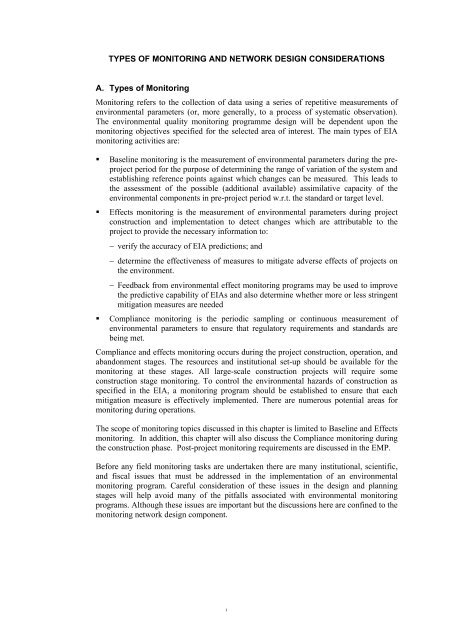Distillieries - Environmental Clearance
Distillieries - Environmental Clearance
Distillieries - Environmental Clearance
You also want an ePaper? Increase the reach of your titles
YUMPU automatically turns print PDFs into web optimized ePapers that Google loves.
TYPES OF MONITORING AND NETWORK DESIGN CONSIDERATIONSA. Types of MonitoringMonitoring refers to the collection of data using a series of repetitive measurements ofenvironmental parameters (or, more generally, to a process of systematic observation).The environmental quality monitoring programme design will be dependent upon themonitoring objectives specified for the selected area of interest. The main types of EIAmonitoring activities are:Baseline monitoring is the measurement of environmental parameters during the preprojectperiod for the purpose of determining the range of variation of the system andestablishing reference points against which changes can be measured. This leads tothe assessment of the possible (additional available) assimilative capacity of theenvironmental components in pre-project period w.r.t. the standard or target level.Effects monitoring is the measurement of environmental parameters during projectconstruction and implementation to detect changes which are attributable to theproject to provide the necessary information to:− verify the accuracy of EIA predictions; and− determine the effectiveness of measures to mitigate adverse effects of projects onthe environment.− Feedback from environmental effect monitoring programs may be used to improvethe predictive capability of EIAs and also determine whether more or less stringentmitigation measures are neededCompliance monitoring is the periodic sampling or continuous measurement ofenvironmental parameters to ensure that regulatory requirements and standards arebeing met.Compliance and effects monitoring occurs during the project construction, operation, andabandonment stages. The resources and institutional set-up should be available for themonitoring at these stages. All large-scale construction projects will require someconstruction stage monitoring. To control the environmental hazards of construction asspecified in the EIA, a monitoring program should be established to ensure that eachmitigation measure is effectively implemented. There are numerous potential areas formonitoring during operations.The scope of monitoring topics discussed in this chapter is limited to Baseline and Effectsmonitoring. In addition, this chapter will also discuss the Compliance monitoring duringthe construction phase. Post-project monitoring requirements are discussed in the EMP.Before any field monitoring tasks are undertaken there are many institutional, scientific,and fiscal issues that must be addressed in the implementation of an environmentalmonitoring program. Careful consideration of these issues in the design and planningstages will help avoid many of the pitfalls associated with environmental monitoringprograms. Although these issues are important but the discussions here are confined to themonitoring network design component.i

















